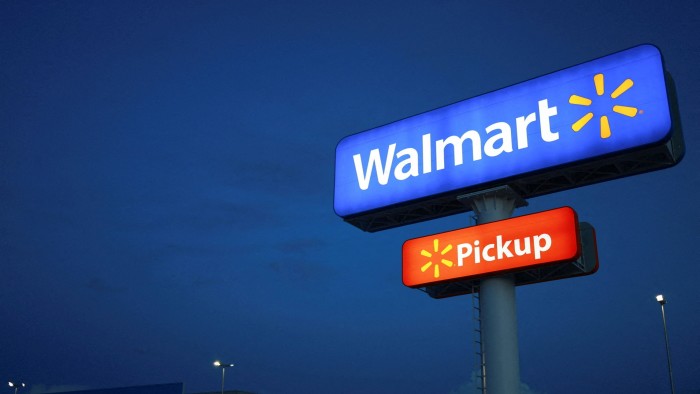Unlock the Editor’s Digest for free
Roula Khalaf, Editor of the FT, selects her favourite stories in this weekly newsletter.
Maybe you’ve heard recently about the Walmart Recession Signal, invented by retired Wells Fargo Asset Management strategist Jim Paulsen. Here’s a Bloomberg article about it, and here’s Paulsen’s own write-up on Substack.
The idea is to compare Walmart’s share price with a basket of luxury goods stocks. “As economic activity slows and recession risk builds, retailing purchasing patterns tend to gravitate toward discounters like Walmart and away from luxury retailers,” Paulsen writes. “Consequently, a rise in the WRS could warn of a potential recession.”
It’s a cool graph!
One problem is with the benchmark, because the S&P Global Luxury Index is a weird, fussy thing. Weighting is by float-adjusted market value multiplied by a subjective “luxury exposure score”. S&P groups constituents into four buckets — minimum, moderate, significant or maximum bling — then deflates their market caps accordingly. Single-stock weights are also capped on a sliding scale based on which luxury exposure bucket they’re in.
Trying to put a see-through value on the luxury bits of conglomerates is a nice idea that has some odd effects. For example: the sixth-biggest stock in the index by weight, according to the end-November index fact sheet, is Tesla, which is more about fantasy goods than luxury ones. In tenth place is Diageo, the Guinness brewer, whose super-premium brands account for about a quarter of overall revenues. Hoteliers Hilton and Marriott are top-ten stocks based on upper-upscale brands that account for hardly any of their available rooms.
Subjectivity also affects the pure-play luxury stocks. Hermes, Ferrari and Richemont are all bigger by index weight than LVMH Moët Hennessy Louis Vuitton, which is presumably to do with free float but might equally be a handicap because it owns a newspaper and a playground. How many LVMH shareholders care, or even know, about these sidelines is open to question.
Here’s a scatter plot of all 80 stocks in the index. They’re a disparate bunch:
The long-term trend in luxury goods has been bifurcation, with LVMH and super-premium monobrands like Hermès and Ferrari taking market share from the weaker and dowdier operators. Then, over the past year or so, the whole sector has struggled. Prestige brands tried price gouging amid a China-led slowdown and growing evidence that GenZ don’t care that much about an authentic label.
These trends are playing out across the luxury goods universe in lots of different ways. They can’t be summarised easily by an index that bundles together housebuilders, cruise ship operators, yacht builders and a mattress maker.
A different way to look at the world is to plot Walmart’s share-price performance relative to individual pure-play luxury companies. From Ferrari’s China-proof managed scarcity to Kering’s failure to keep Gucci relevant, the charts don’t really tell one story any more.
Walmart, too, has its own stuff going on. It has attracted wealthier customers, which kind of undermines the driving idea behind the indicator. The stock’s up nearly 90 per cent this year on an expansion of international general-retail and a push into higher margin marketplace-type services. Its 2023 analyst day set a target of up to 8 per cent annual operating profit growth on revenue growth of 4 per cent. Its forward PE was 24 at the start of the year and is 36x today. The story is about much more than sales volumes.
Paulsen says on his Substack today that there’s no sign of recession fear in corporate credit spreads. If it weren’t for a weird index and a fiddly sector, his Walmart Recession Signal would probably be saying the same thing.
Read the full article here

